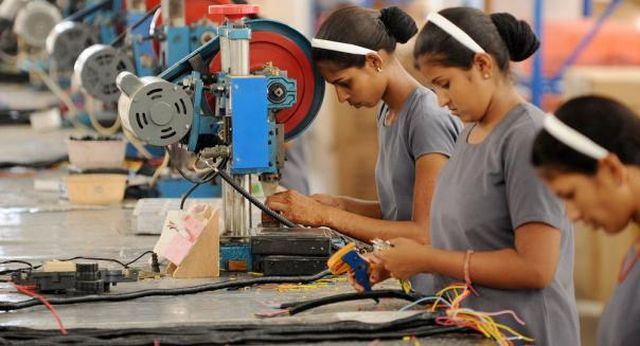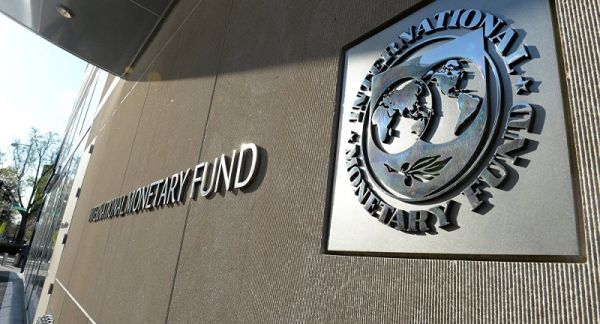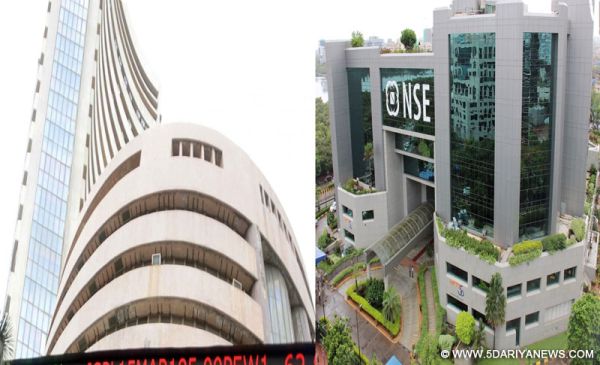
by admin | May 25, 2021 | Business Ideas, Economy, Entrepreneurship, Markets, News, Women Entrepreneur
 By Arul Louis,
By Arul Louis,
United Nations : India must focus as a priority on ensuring that more women work in the formal sector as it continues with labour reforms, according to Ken Kang, the deputy director in International Monetary Fund (IMF) Asia Pacific Department.
While “in recent years India has made very impressive progress in reforms,” he said that “looking ahead there are important policy priorities” and listed three among them.
“One, is to continue improvements in product and labour market reforms with a focus on increasing formal female labour participation to improve the business environment, and reduce complex regulations, but also to address supply bottlenecks, particularly in the agricultural sector and distribution networks,” Kang said at a news conference on Friday in Washington.
As one of India’s major reform achievements, he mentioned the “introduction of flexible inflation targeting and of a statutory monetary policy which has helped to strengthen the monetary policy framework.”
The Reserve Bank of India Act was amended in 2016, to provide for a Monetary Policy Committee that decides on the interest rate required for achieving the inflation target set by the government in consultation with the bank.
The other achievements include the Goods and Services Tax (GST) and the “major recapitalisation plan for the public-sector banks in order to accelerate the work out of nonperforming loans, as well as made some important legal improvements through a new insolvency and bankruptcy law,” Kang said.
“We expect and hope that the reform momentum continues,” he added.
“We are not saying that India’s structural reform speed will slow down because of elections,” Changyong Rhee, the IMF director of the Asia Pacific Department said.
“What we are saying is that the growth momentum and the structural reform momentum should continue despite the election period. So there is something misquoted,” he added.
On Thursday, IMF Managing Director Christine Lagarde had said at a news conference on Thursday, according to the IMF transcript: “We have seen and we are seeing — I am not sure that we will be seeing in the next few months given the elections that are coming up — major reforms that we had recommended and advocated for a long time.”
(Arul Louis can be reached at arul.l@ians.in)
—IANS

by admin | May 25, 2021 | Opinions
 By Amit Kapoor,
By Amit Kapoor,
All economies want to produce more within national borders. This urge arises from the popular belief that manufacturing is a good source of jobs for low-skilled workers. President Donald Trump’s fixation with bringing back jobs to American factory floors by any means necessary is merely an extension of the same age-old fetish for manufacturing.
But, according to the International Monetary Fund (IMF), the obsession with manufacturing jobs has gone too far. The IMF’s World Economic Outlook released last week found that manufacturing is not a key determinant of productivity in developed economies and is not a necessary stage of development for emerging ones.
The IMF’a basic argument is that the shift of workers from manufacturing to services in the advanced world and the shift in job type from agriculture directly to services for the emerging economies has not had any negative effects on either economic growth or productivity. The report found “a sizeable overlap” between the growth in labour productivity between manufacturing and services sub-sectors. In fact, some service sectors also exhibit higher productivity growth rates than the leading manufacturing industries.
Therefore, since these structural changes across economies is effectively enhancing productivity, which determines the standard of living, the stress on revitalising the manufacturing sector seems unnecessary.
The bias towards manufacturing has been true for the field of economics since the time of Adam Smith. While writing “The Wealth of Nations” in the shadow of the Industrial Revolution, Smith was expectedly charmed by the potential of the manufacturing sector for economies. He wrote that labour, which provides services, does not provide any value: “Like the declamation of the actor, the harangue of the orator, or the tune of the musician, the work of all of them perishes in the very instant of its production.”
Would Smith’s view have changed in modern times? Probably yes. Linda Yueh in her brilliant new book, “The Great Economists: How Their Ideas Can Help Us Today”, argues that due to rapid technological advancements since Smith’s time, the tune of the musician, which he regarded as ephemeral, now holds tangible value. Also, since Smith believed in the power of the invisible hand of the markets, he would have derided any move towards introducing market distortions like the Trump tariffs to promote manufacturing.
This does not imply that the government should sit back and do nothing. On the contrary, it should focus on creating a business-friendly environment instead of prioritising one part of the economy over the other.
It is also necessary to understand that good old manufacturing of the Henry Ford era is not achievable in the 21st century. Since the advent of technology, manufacturing has not remained a labour-intensive job. So, no amounts of tariffs can turn the clock back.
In the case of India, however, the IMF’s argument that it is not worrisome to directly transition from an agricultural-led to a service-led economy and skipping the stage of industrialisation since it has not affected productivity levels might not seem as reassuring. The fact of the matter remains that India has been unable to create jobs. Between 2004 and 2012, a period during which India experienced its highest growth phase in history and for which conclusive data for jobs is available, GDP grew at 8.1 percent per annum while jobs grew at a paltry two percent.
A report by The Boston Consulting Group (BCG) and the Confederation of Indian Industry (CII), “India: Growth and Jobs in the New Globalisation”, published last year, revealed that almost all of India’s growth since 1991 has come due to higher capital investment. The contribution of labour to India’s growth has been low or negligible during the period. The total factor productivity has been fluctuating and clearly most of it was being driven by a growth in productivity of capital. So, even though the IMF might be right in arguing that missing the industrialisation phase did not impact productivity, it does seem to have had a high bearing on the capacity of job creation.
But the emerging economies of our times, including India, do not have the luxury of leveraging on the job-generating capacity of the manufacturing sector. Programmes like Make in India cannot help in reviving that capacity in an increasingly mechanised world. India needs to play on its strengths instead, which lie in its robust service sector. Between 2010 and 2014, India’s service sector grew at 8.6 percent per annum; faster than the service economies of China and the US. Moreover, since global growth in services trade has been outpacing merchandise trade, the sector provides immense growth potential.
A possible solution lies in harnessing jobs from the growing “servitisation” of businesses or the shift towards provision of services to supplement traditional product offerings. The classic example is the Rolls-Royce airplane engine programme, where consumers “pay by the hour” for the use of the engine rather than paying for the engine itself and the company, in turn, assures regular repairs. Such shifts in business models offer significant opportunities for job creation and growth within the service sector.
The times they are a changin’ and the ideas to power economic growth need to keep up.
(Amit Kapoor is chair, Institute for Competitiveness. The views expressed are personal. He can be contacted at amit.kapoor@competitiveness.in and tweets @kautiliya. Chirag Yadav, senior researcher, Institute for Competitiveness, has contributed to the article)
—IANS

by admin | May 25, 2021 | Economy, Markets, News
 By Porisma P. Gogoi,
By Porisma P. Gogoi,
Mumbai : Revival in corporate earnings, along with the country’s healthy economic growth outlook projected by the International Monetary Fund (IMF) and massive inflow of foreign funds kept the bulls riding in the Indian equity markets during the truncated trade week ended Thursday.
However, the key indices took a breather on the last trading day (Thursday) and closed in the red — snapping a six-day gaining streak — as investors booked profits amid higher crude oil prices and caution over January derivatives expiry, market observers said.
Nevertheless, it was the eighth consecutive week of gains for the benchmark indices.
The barometer 30-scrip Sensitive Index (Sensex), which crossed the psychologically important 36,000-mark during the week, surged by 538.86 points or 1.52 per cent to close at 36,050.44 points.
The wider Nifty50 of the National Stock Exchange (NSE) crossed the 11,000-points-level for the first time during the week and closed Thursday’s trade at 11,069.65 points — up 174.95 points or 1.60 per cent from its previous week’s close.
The indices scaled new records during the week.
On January 24, the BSE Sensex closed at a new high of 36,161.64 points after scaling a new high of 36,268.19 points during the intra-day trade.
On the same day, the Nifty50 closed at a new high of 11,086 points, after it scaled a fresh intra-day high of 11,110.10 points.
“Markets got a boost in the backdrop of budget expectations apart from positivity among investors on account of trade talks being held at Davos,” D.K. Aggarwal, Chairman and Managing Director of SMC Investments and Advisors, told IANS.
“Also, the bulls got support after government announced that it would infuse Rs 88,139 crore into 20 public sector banks through recapitalisation bonds and budgetary support in this financial year. The aim of the government is to strengthen these banks’ lending capacity and thereby pulling the country out of a three-year low credit growth,” he added.
The government on Wednesday announced plans to infuse over Rs 1 lakh crore, including Rs 80,000 crore through recap bonds and Rs 8,139 crore as budgetary support, during the current fiscal seeking to perk up public sector banks (PSBs) that have been hit by huge non-performing assets.
“Post re-capitalisation allocation worth Rs 880 billion, PSBs corrected. However, private bank and infra stocks gained,” Arpit Jain, AVP at Arihant Capital Markets, told IANS.
“FIIs (foreign institutional investors) were net buyers during the month of January worth $1 billion,” said Jain.
On the investment side, provisional figures from the stock exchanges showed that FIIs purchased scrips worth Rs 4,510.59 crore, while domestic institutional investors divested stocks worth Rs 1,452.38 crore during the week.
Figures from the National Securities Depository (NSDL) revealed that foreign portfolio investors bought equities worth Rs 5,990.74 crore, or $939.38 million, during January 22-25.
According to Vinod Nair, Head of Research, Geojit Financial Services, positive global cues and revival in earnings supported the underlying sentiments.
“The rally was broadbased led by IT, oil and gas, financials, metals, pharma and PSBs. In the latest World Economic Outlook, the IMF has projected India’s GDP to grow at 7.8 per cent which helped the investor sentiments,” said Nair.
“F&O (futures and options ) expiry, long weekend, oil prices at three year at $71/bbl, lack of fresh triggers post a series of new high and sell-off in PSB stocks limited gains for the week,” he added.
On the currency front, the rupee strengthened by 30 paise to close at 63.55 against the US dollar from its last week’s close at 63.85.
The top weekly Sensex gainers were: ONGC (up 7.32 per cent at Rs 208.25); Tata Consultancy Services (up 7.14 per cent at Rs 3,117.85); Yes Bank (up 6.83 per cent at Rs 363.50); Coal India (up 5.85 per cent at Rs 299.65); and Adani Ports (up 5.61 per cent at Rs 437.60).
The losers were: Bharti Airtel (down 8.47 per cent at Rs 452.60); Tata Motors (DVR)(down 6.10 per cent at Rs 228); Tata Motors (down 4.44 per cent at Rs 400.20); Wipro (down 4.32 per cent at Rs 311.95); and Asian Paints (down 3.36 per cent at Rs 1,149.75).
The equity markets were closed on January 26 (Friday) for Republic Day.
(Porisma P. Gogoi can be contacted at porisma.g@ians.in)
—IANS

by admin | May 25, 2021 | Economy, News, World
 Washington : The global economy will expand faster next year while still facing challenges, such as low productivity, high income inequality and low inflation, according to a senior International Monetary Fund (IMF) official.
Washington : The global economy will expand faster next year while still facing challenges, such as low productivity, high income inequality and low inflation, according to a senior International Monetary Fund (IMF) official.
“The most recent IMF forecast, issued in July, projected global growth at 3.5 per cent this year and 3.6 per cent in 2018… The Fund will issue its next World Economic Outlook in a week, and there is every reason to see these trends continuing,”Zhang Tao, deputy managing director of the IMF, said on Monday.
Zhang said the IMF’s emergency lending has declined as countries have found their financial footing again as the impact of the global crisis fades, reports Xinhua news agency.
However, he warned of the challenges the global economy is still facing, such as low productivity growth, income polarisation in some advanced economies, and low inflation.
“Innovation has reshaped labour and product markets. However, this disruptive change has taken place without an apparent increase in productivity,” said Zhang.
Low productivity growth has also contributed to the rise of income inequality in advanced economies, because it has become more difficult to raise living standards due to low productivity, according to the official.
Another challenge facing the global economy is low inflation linked to the low level of wage growth, said Zhang.
He attributed low wage growth to structural forecasts, such as weak productivity growth, aging population and the increasing consolidation of companies.
“Achieving stronger growth will require the right combination of policies, especially to reinforce labour and capital markets,” said Zhang.
He called for a range of reforms to improve efficiency and competitiveness of the global economy.
—IANS

by admin | May 25, 2021 | Islamic Banking, Islamic Finance, Muslim World, News, World
 By Maeeshat.in Desk,
By Maeeshat.in Desk,
UAE, July 15: The International Monetary Fund, in its latest report, has admitted growth of Islamic finance and banking in the United Arab Emirates. “UAE is also a major hub for Islamic bond issuances―during 2001–15, $53.8 billion or 36 percent of all global sukuk issuances originated in the UAE,” said IMF in the report released on 14th July.
“The UAE banking system is well developed and strong. Its 59 banks provide a full range of services to their clients. The banking system is large, with total assets amounting to AED 2.6 trillion or 204 percent of GDP at end-March 2017. The banking system is concentrated, with the largest three banks holding over 50 percent of total assets of the banking system. Banks are adequately capitalized and profitable…,” said IMF.
“Islamic banking is developing rapidly with some of the world’s largest Islamic banks headquartered in the country. Islamic banks in the UAE had assets of AED 522 billion or 20 percent of total bank assets at end-March 2017,” said International Monetary Fund.
“Capital market development—including the development of Islamic finance—is important to allow companies, governments, and GREs to reduce their reliance on bank financing,” the report on UAE said.



